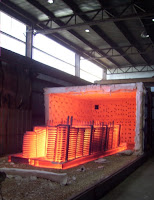 Hamilton, N.J., June 8, 2018 - Hotfoil-EHS, Inc., America's premier manufacturer of industrial heating equipment, announced today the opening of their United Kingdom facility in Birmingham, England.
Hamilton, N.J., June 8, 2018 - Hotfoil-EHS, Inc., America's premier manufacturer of industrial heating equipment, announced today the opening of their United Kingdom facility in Birmingham, England."The opening of our UK facility signals a homecoming of sorts, since our original company, Hotfoil, was founded in the mid-1960's in England,” said Hotfoil-EHS President, Matt Richards. “The Birmingham location makes perfect sense for Hotfoil-EHS. After several ownership changes, my father, Neville Richards, took ownership in 1993." Richards continued, "Since then, we have grown though key acquisition and new product development. This move also is the first step in our aggressive strategy to expand into the international market.”
The new Hotfoil-EHS facility in Birmingham will provide the UK with a large local inventory of power consoles, recorders, ceramic heaters, and a full line of accessories used for heat treatment. Hotfoil-EHS UK will also supply hopper heaters, tank heaters, vessel heaters as well as control systems.
According to UK General Manager David Robbins, “The opportunity to introduce such a high quality product line to the UK is wonderfully exciting. I am delighted to be working with such a well established US company and progressive management team."
About Hotfoil-EHS
Manufacturer of America's premier heat treatment and industrial heating equipment, Hotfoil- EHS is driven by providing the highest quality products, delivering the best customer service, and keeping costs low. Their headquarters and main manufacturing facility is located in Hamilton, NJ and have two additional manufacturing operations in Laporte, TX and Chattanooga, TN.
For more information contact Dean Prassas by emailing dap@hotfolehs.com or by visiting:
https://hotfoilehs.com
https://hotfoilehs.co.uk
https://www.facebook.com/hotfoilehs







